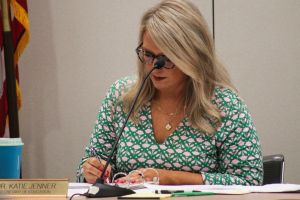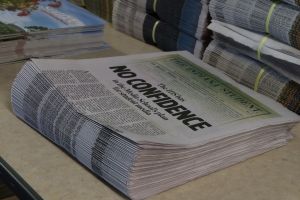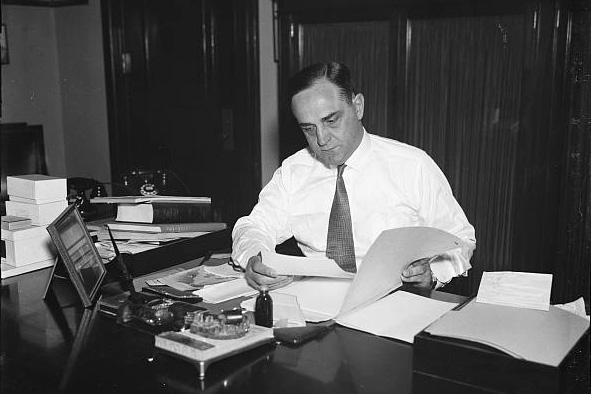
Sherman Minton sits in his senatorial office in this 1936 photograph. A one-term Democratic senator from Indiana, Minton is the last member of Congress to have been appointed to the Supreme Court. (Library of Congress)
With her confirmation to the Supreme Court in October, former Notre Dame law professor Amy Coney Barrett is just the second Supreme Court justice selected from the state of Indiana.
The first was Floyd County’s Sherman Minton.
Before you ask, “What about Chief Justice Roberts?”: Roberts did grow up in Northwest Indiana. However, Roberts was selected to the Supreme Court from the state of Maryland, as he was serving on the Court of Appeals for the District of Columbia at the time.
Reporter Mitch Legan spoke with historians and Supreme Court scholars about Minton, the first Hoosier justice.
A Supreme Court justice from 1949-1956, Sherman Minton was born in Georgetown in 1890, and until recently, was the only person chosen from Indiana to the nation’s highest court.
But for many Hoosiers traveling south, a bridge bearing his name is how you get to Kentucky.
“I used to ask my students the same thing,” said IU Southeast professor emeritus Linda Gugin. “You know, ‘Do you know who the bridge is named for?’ (And the students would respond,) ‘Some guy named Minton? I don't know, who was he?’”
Gugin and her husband, Jim St. Clair, both taught at IU Southeast for decades. They took an interest in Minton and wrote the authoritative biography on the former justice: Sherman Minton: New Deal Senator, Cold War Justice.
“One of the intriguing things about Minton, I think, is that he was born into poverty, a very difficult childhood,” said St. Clair, also a professor emeritus. “And for somebody who had those beginnings, to rise to the position that he did – we thought was remarkable and certainly deserved the biographical treatment.”
Growing up in poverty had a profound impact on Minton, who worked hard from a young age to support both his family and his goal of continuing his education.
In 1911, Minton had enough money to enroll at Indiana University and traveled to Bloomington to study law.
“(Minton and a friend) would go pick berries to have something to eat,” St. Clair said. “I mean, it really was a poverty existence that they experienced as undergraduates.”
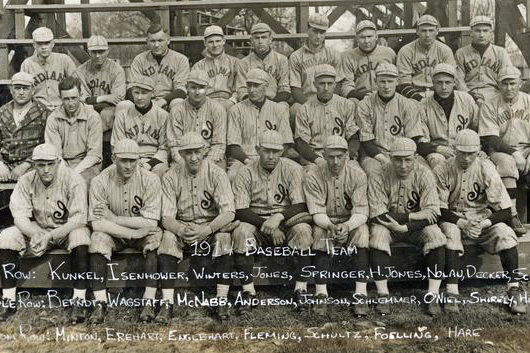
Minton (bottom left) stares straight ahead in this photo of the IU baseball team from the 1914 Arbutus. (Indiana University Archives)
Still, Minton was a stellar student-athlete, finding enough time to study law and play on the IU baseball and football teams.
“Baseball was probably his most favorite (sport) and the one (he was) most talented in,” said Floyd County Historical Society president Dave Barksdale, holding a 1910 edition of “The Vista,” the New Albany High School yearbook. “He played center field. And from his yearbook, it says: ‘Best fielder and base runner ever in the school.’ So, quite an athlete.”
Minton’s time at IU would prove impactful outside of just getting a legal education. While studying in Bloomington, he befriended two men who would become influential on the political scene: Paul McNutt and Wendell Willkie.
“One of the significant things that happened to him at Indiana University is he became very close friends with Paul McNutt, who would later be (Indiana) governor and really launch Minton’s political career,” Gugin said.
After Minton returned from World War I and reopened his law practice in New Albany, Gov. McNutt chose him to head the state’s Utility Regulation Commission. Minton, a fellow Democrat, used his success in lowering rates there to catapult to a new position in 1935: U.S. Senator from Indiana.
“There were so many Democrats elected that year that they had trouble seating everybody. And as it turns out, Minton was seated next to Harry Truman,” St. Clair said. “And that was the beginning of a long friendship.”
During his single term in the Senate, Minton became President Franklin Delano Roosevelt’s right-hand man in Congress, and stumped hard for the president’s New Deal programs as a response to the Great Depression.
“I think that's one of the things that he tried to do in his political career, is help people who were in similar situations that he experienced,” St. Clair said.

But the Supreme Court would rule many of the initiatives unconstitutional, which influenced Minton’s view of the court and made him the No. 1 senator pushing the president’s court-packing plan. Minton had come up with his own plan but deferred to the president’s when he caught wind of it. President Roosevelt wanted to add seats to the bench and impose a mandatory retirement age so he could appoint justices who would be more favorable to his New Deal programs.
“Minton said, ‘We're not trying to pack the court. It's those nine old men that are packing the court – they won't get off the court.’ And of course, that issue has come up again,” Gugin said.
The court-packing plan proved unpopular, and Minton lost his bid for reelection in 1940. Fellow IU grad Wendell Willkie, a Republican, carried the state in the presidential race.
For his efforts on the New Deal, President Roosevelt appointed Minton to the 7th Circuit Court of Appeals. About eight years later a vacancy opened on the Supreme Court, and sure enough, Minton’s old buddy – now President Harry Truman – was in position to fill the seat.
“When they had his hearings, the one thing that came up for him was his partisanship,” Gugin said. “In the same way, I think for Barrett, the one thing that's come up for her is her conservatism.”
READ MORE: Meet The Controversial 1949 Supreme Court Nominee From Indiana
At the time, Minton was the most educated man to sit on the high court, having studied law at IU and gotten his master’s at Yale. He remains the last member of Congress appointed to the Supreme Court.
Minton's seven years on the court were quite conservative compared to his time in the Senate because of his belief in judicial restraint, or the idea that judges should avoid making policy and overstepping their role in the government’s three-branch system.
“Judicial restraint was the way [Minton] saw the role of the court because he had lived through that New Deal experience in the Senate,” said IU faculty member Beth Cate, a Supreme Court expert in the O’Neill School of Public and Environmental Affairs. “(Having the Supreme Court) striking down legislation using the Constitution – he came onto the court not a fan of that approach.”
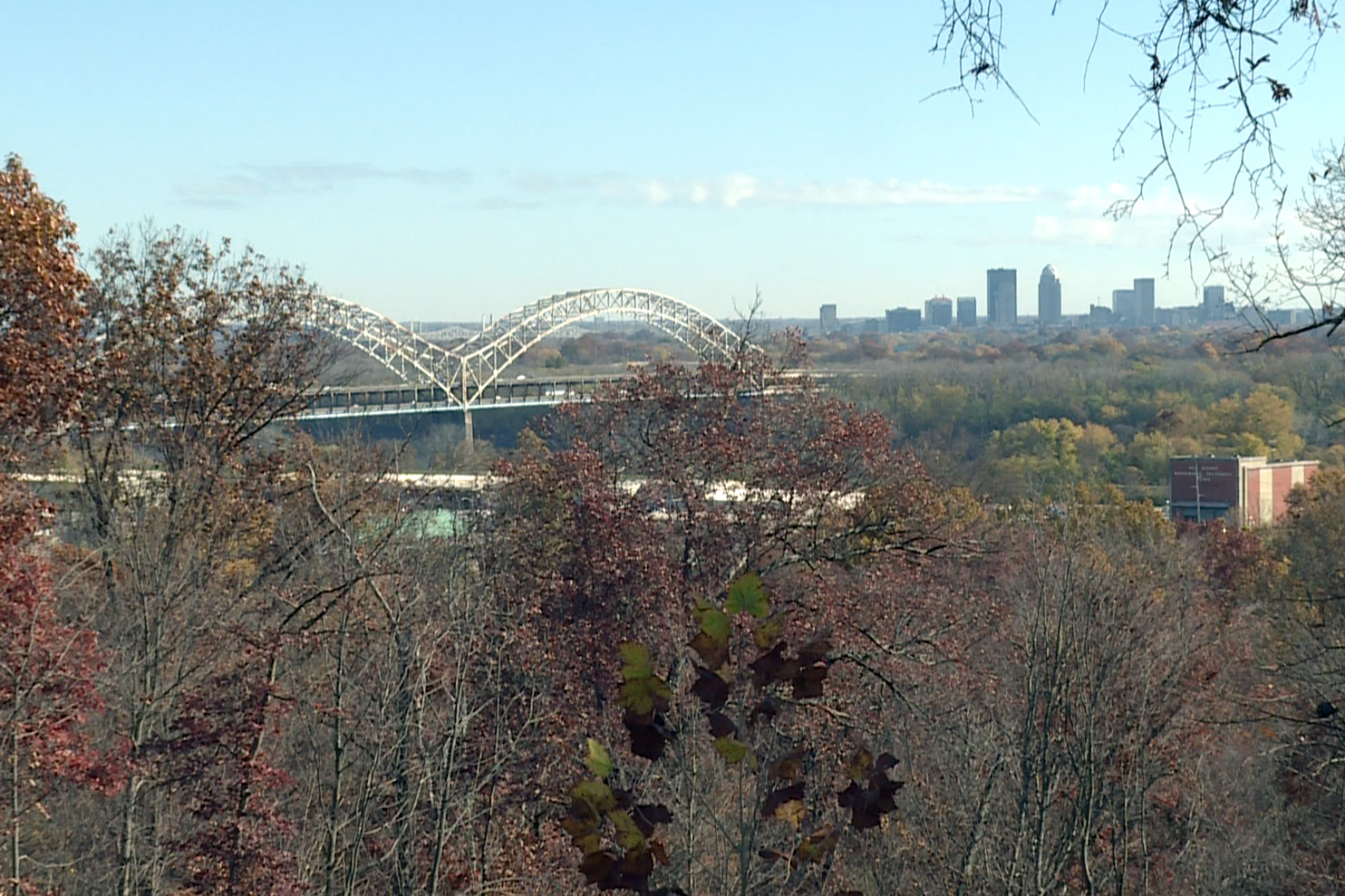
He did, however, break with this ideology as a key vote in overturning segregation in schools in Brown v. Board of Education, his most lasting contribution to the court, according to Gugin.
She says the issues of segregation and racial equality were especially important to Minton, who also ruled against racially restrictive housing covenants while on the court.
At the point when Brown v. Board was decided, Minton’s health had been deteriorating, and he would serve just two more years on the Supreme Court before retiring and moving back to New Albany in 1956.
“He was a very modest person,” St. Clair said. “He wasn't somebody who was going to put himself in the limelight. And he came back to New Albany and just kind of blended in.”
Six years later, the bridge connecting New Albany with Louisville was completed and named after Minton. Three years after that, Minton died on April 9, 1965.
Cate said Justice Barrett is similar in her belief in judicial restraint and relying on settled precedent, although her originalist outlook and young age put her in the position to have a major impact on the court in the years to come.
She says gun rights is one issue on which Barrett could make a difference.
“After (the Supreme Court) announced that people have an individual right under the Second Amendment to a functional firearm for home self-defense, they've really tried to avoid hearing more gun control cases,” Cate said. “There have been four votes to take those cases, but without a fifth vote to actually overturn some gun control measures, the court just hasn't pulled in those cases. I think they've got that fifth vote in Amy Coney Barrett.”
Whether Hoosiers will name a bridge after her remains to be seen. But down in New Albany, Justice Barrett gives educators such as Barksdale an opportunity to discuss Floyd County’s favorite son.
“We want the next generations to understand, first of all, why the bridge is named what it’s named,” Barksdale said. “And then get into more of what he meant to the city, to the state and to the nation when you think about his accomplishments.”








